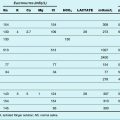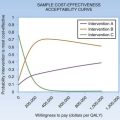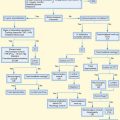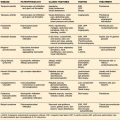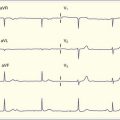156 Hypoglycemic Agent Overdose
• Hypoglycemia is defined either by serum glucose level or on the basis of symptoms.
• Typically, an adult has enough glycogen to last approximately 6 to 8 hours.
• Insulin treatment is the most common cause of hypoglycemia in adults with diabetes.
• Extreme glucose values (either high or low) and hypoperfusion can cause a significant discrepancy in bedside glucose testing results.
• Sodium bicarbonate administered to alkalinize the urine has been shown to reduce the half-life of the sulfonylurea chlorpropamide.
• Patients with overdoses (intentional or unintentional) of insulin, sulfonylureas, and meglitinides should be admitted for inpatient observation because of the unpredictable kinetics of these agents.
Epidemiology
For the purposes of this chapter, the term hypoglycemia refers to the condition of blood glucose concentration for which medical intervention is usually necessary. It is occasionally referred to in the literature as severe hypoglycemia.1
The exact incidence of hypoglycemia in nondiabetic persons is unknown. However, in patients with diabetes mellitus (DM), the occurrence of hypoglycemia depends on factors such as whether the patient has type 1 or type 2 DM and what type of pharmacologic therapy the patient is receiving (i.e., insulin, an oral antihyperglycemic agent). In patients with type 1 DM, hypoglycemia reportedly occurs at an approximate rate of 1.1 to 3.2 episodes per patient per year.2
The diagnosis is often made empirically by prehospital care providers before the patient’s arrival in the emergency department (ED); however, death resulting from hypoglycemic coma may still occur if the condition is unrecognized.3 A few patients intentionally overdose, and treating them can be extremely difficult. This chapter discusses important factors in the evaluation and treatment of patients with toxicity secondary to hypoglycemic agent overdose.
Pathophysiology
The primary metabolic substrate for the central nervous system (CNS) is glucose. Usual sources of glucose are diet, endogenous production (through gluconeogenesis), and storage (through glycogenolysis). Serum glucose concentrations are relatively tightly controlled by physiologic mechanisms. After dietary sources of glucose are completely used, glycogenolysis is the major physiologic mechanism for maintaining euglycemia. Typically, an adult has enough glycogen to last approximately 6 to 8 hours. When glycogen stores are depleted, gluconeogenesis, which is fueled by amino acids from muscle, takes over. The CNS cannot make or store glucose, and it relies on the previously mentioned mechanisms to maintain normal metabolic activity during fasting periods. As glucose use exceeds glucose production and serum glucose concentrations decrease, various counterregulatory pathways are activated. Counterregulatory pathways triggered at the glycemic threshold are increases in glucagon, epinephrine, growth hormone, and cortisol. Glycemic thresholds are fairly reproducible in research studies on healthy subjects, but these thresholds can vary significantly among patients with both type 1 and type 2 DM. These thresholds also depend on other factors, such as tightness of glucose regulation, the presence of chronic hyperglycemia, and recent episodes of hypoglycemia.4
Hypoglycemic agents induce hypoglycemia by various mechanisms. Insulins cause rapid transport of amino acids and glucose intracellularly. Sulfonylureas stimulate insulin secretion by binding to specific membrane receptors on the pancreatic beta-islet cell. These drugs also benefit glucose homeostasis by decreasing hepatic glucose production and improving insulin sensitivity at the receptor and postreceptor levels.5 Other drugs may induce hypoglycemia by inhibition of gluconeogenesis, glycogenolysis, counterregulatory hormones, or other unknown mechanisms. Ethanol, a toxin commonly encountered in the ED, inhibits gluconeogenesis by depleting nicotinamide adenine dinucleotide and also inhibits the effects of cortisol, growth hormone, and epinephrine.1
Presenting Signs and Symptoms
The symptoms of hypoglycemia can be divided into two basic groups: hyperadrenergic symptoms and neuroglycopenic symptoms (Box 156.1). Hyperadrenergic symptoms are more common with a rapid decrease in glucose and result from autonomic nervous system stimulation (both sympathetic and cholinergic). The other clinical features of hypoglycemia are mediated through altered brain activity; the resulting constellation of signs and symptoms of hypoglycemia is termed neuroglycopenia.6 Three neuroglycopenic syndromes are described: acute, subacute, and chronic.7 Subacute neuroglycopenia is characterized by episodic disorientation, somnolence, slurring of speech, personality changes, amnesia, and loss of consciousness. Precipitous loss of consciousness may occur as the sole manifestation of subacute neuroglycopenia. Both subacute and acute forms of neuroglycopenia may manifest as acute neurologic deficits (e.g., transient hemiplegia), strabismus, hypothermia, hyperthermia, seizures, and automatism. Chronic neuroglycopenia is a rare condition that usually occurs in patients with insulinoma and in patients with DM who are treated with excessive insulin and who demonstrate a gradual progressive mental illness similar to a chronic psychiatric disorder.7
Differential Diagnosis and Medical Decision Making
Hypoglycemia has numerous causes and may be classified into the following three categories: (1) postprandial, (2) fasting, and (3) drug- or toxin-induced (Table 156.1).1 In healthy patients, fasting hypoglycemia is usually the result of unintentional or intentional drug ingestion and insulinoma. In patients who are severely ill or hospitalized, hypoglycemia may be a complication of the illness, drug interactions, or other iatrogenic factors.
| TYPE OF HYPOGLYCEMIA | CAUSES |
|---|---|
| Postprandial |
For adults with DM, insulin treatment is the most common cause of hypoglycemia. Factors associated with higher frequency of hypoglycemia in patients with type 1 DM include lower hemoglobin A1c, higher daily insulin requirements, longer duration of DM, and a previous history of hypoglycemia. Approximately 25% of patients with DM are unable to recognize impending hypoglycemia because of a lack of autonomic warning symptoms; this characteristic is also an important predictor of hypoglycemia.1 Patients with insulin-dependent type 2 DM are also susceptible to hypoglycemia, especially if their disease has been treated with insulin for a long time and if their DM is tightly controlled.8
For patients who are taking oral agents rather than insulin, sulfonylureas are a common cause of hypoglycemia. According to the 2010 annual report of the American Association of Poison Control Centers’ Toxic Surveillance System, 4109 reported sulfonylurea exposures, with 38 major outcomes and 1 death, occurred in 2009.9 The incidence of hypoglycemia secondary to these agents rises in older patients and with long-acting agents (e.g., chlorpropamide).10 Consequently, independent risk factors for hypoglycemia include recent hospitalization, advanced age, and polypharmacy. Other risk factors for sulfonylurea-induced hypoglycemia are hepatic and renal dysfunction because of decreased metabolism (e.g., glyburide, glibenclamide, glipizide) and decreased elimination (e.g., chlorpropamide, glyburide). The most commonly used sulfonylureas have a duration of effect of at least 24 hours, and hypoglycemia in a patient taking such an agent can be prolonged, especially in the setting of overdose. In one case report, sulfonylurea-induced hypoglycemia was reported to last up to 27 days.11 Most other oral agents (e.g., thiazolidinediones, biguanides) used for the treatment of DM do not usually cause significant hypoglycemia.
Hypoglycemia is a simple diagnosis to make, provided it is considered early in a patient’s presentation. In most cases, hypoglycemia is considered in a patient with altered sensorium or depressed mental status. Bedside blood glucose testing using a glucose meter in the patient with neuroglycopenic symptoms is generally the fastest technique, as well as a fairly reliable method, to determine hypoglycemia. In general, the correlation of capillary blood glucose levels (which are measured by a glucose meter) with venous or arterial glucose measurements seems to be good.12,13 At extreme values (either high or low) and in cases of systemic hypoperfusion, however, a clinically significant discrepancy may be apparent. In the setting of suspected hypoglycemia, confirmatory laboratory testing of a serum specimen is therefore necessary. Furthermore, because symptoms of hypoglycemia vary among individuals, hypoglycemia is still a possible diagnosis even in a patient with a glucose level categorized as euglycemic.14
Treatment
The emergency physician must institute basic supportive measures, with particular attention to airway, breathing, and circulation, along with cardiorespiratory monitoring on encountering the obtunded patient with hypoglycemia (Box 156.2 has a treatment summary). Supplemental oxygen, intravenous (IV) thiamine, and naloxone are generally benign therapies that may be judiciously administered in a patient with depressed mental status of unknown origin.
Box 156.2 Treatment of Hypoglycemic Agent Overdose
1. Basic support measures with attention to airway, breathing, circulation, and cardiopulmonary monitoring
2. Bedside glucose testing and an immediate bolus of glucose; hypoglycemia treated with IV glucose for severe episodes and when associated with obtundation: 0.5-1 g/kg of D50W for adults and of D25W for children
3. Consideration of thiamine and naloxone for obtunded patients
4. After initial euglycemia, continuous IV infusions of dextrose (D5W or D10W) started and boluses repeated when indicated
5. Decontamination with activated charcoal, either a single dose or multiple doses, for agents such as glipizide (enterohepatic circulation)
6. Enhanced elimination with IV sodium bicarbonate to alkalinize urine and reduce the half-life for long-acting sulfonylureas (e.g., chlorpropamide)
7. Observation and admission for signs of neuroglycopenia and repeated serum glucose checks every 1 to 2 hr; monitoring of serum electrolyte levels every 4 hr
8. Octreotide, 50 mcg given subcutaneously every 6 to 8 hr, for at least 24 hr, in cases of prolonged hypoglycemia secondary to long-acting sulfonylurea overdose
D5W, D10W, D25W, and D50W, 5%, 10%, 25%, and 50% dextrose in water, respectively; IV, intravenous.
After the primary survey has been performed and any needed measures taken, gastrointestinal decontamination should be considered for patients who have taken an intentional oral overdose of a hypoglycemic agent. The particular modality of decontamination implemented depends on the usual factors, such as time of ingestion, quantity of tablets, mental status of the patient, and potential harm to the patient. Activated charcoal has been shown to be very effective in binding to multiple sulfonylurea agents in vitro.15 A single dose of activated charcoal may be beneficial in these ingestions. In theory, multiple-dose activated charcoal may enhance elimination of the sulfonylurea glipizide because glipizide undergoes enterohepatic circulation.5 IV sodium bicarbonate administered to alkalinize the urine has been shown to reduce the half-life of the sulfonylurea agent chlorpropamide.16 These and other forms of decontamination and enhanced elimination should be used on a case-by-case basis.
IV dextrose is the preferred treatment for severe hypoglycemia with obtundation and a patient’s inability to take oral carbohydrates. The administration of 0.5 to 1 g/kg of IV dextrose rapidly reverses the clinical effects of hypoglycemia. Hypertonic dextrose solutions are commonly found in syringes containing 50 mL of 50% dextrose in water (D50W), which is equivalent to 25 g of dextrose (4 calories/g of glucose or 100 calories). An average man weighing 70 kg would therefore require 35 to 70 g of dextrose. Administration of hypertonic dextrose is fairly safe, and only a few cases of significant adverse effects such as seizures, hyperosmolar coma, and death have been reported.17 A much more common effect is phlebitis, which can be mitigated by injection of the dextrose into a large vein, followed by a saline flush.1
Glucagon may also be administered by the subcutaneous, intramuscular, or IV route to stimulate hepatic glycogenolysis. Glucagon is most beneficial if it is given soon after the onset of hypoglycemic coma and to treat hypoglycemia in type 1 DM.1,17 Glucagon is less effective in patients with type 2 DM because it causes the release of insulin.18 These patients are also likely to already have depleted glycogen stores, thus limiting the efficacy of glucagon. Furthermore, glucagon administration may cause nausea and vomiting, which impair the ability to give oral carbohydrate therapy. Hypertonic IV dextrose is therefore the preferred initial therapy in the setting of acute hypoglycemia.
In patients with sulfonylurea-induced hypoglycemia, the same supportive measures as previously described are initially implemented. Occasionally, prolonged hypoglycemia may occur after a sulfonylurea overdose, especially with the long-acting agents. Antidotal therapy with octreotide should be considered in such refractory cases. A synthetic somatostatin analogue, octreotide inhibits the secretion of several neuropeptides, including insulin, and it is used clinically to suppress excessive growth hormone secretion, inhibit thyrotropin-secreting pituitary adenomas, and treat certain gastrointestinal and pancreatic neuroendocrine tumors (e.g., carcinoid insulinomas).17
Previously, the antihypertensive diazoxide was the recommended agent of choice for refractory hypoglycemia resulting from a sulfonylurea because of its ability to inhibit insulin secretion by opening adenosine triphosphate (ATP)–sensitive potassium (KATP) channels in pancreatic beta-islet cells.19 Although the use of octreotide for sulfonylurea-induced hypoglycemia is “off label” (i.e., the agent has not been approved by the U.S. Food and Drug Administration for this purpose), multiple case reports and research document its efficacy and safety. On the contrary, diazoxide has been shown to be less effective and has several undesirable properties.20 Diazoxide is usually administered by IV infusion, and its efficacy is limited in these situations because of associated hypotension, tachycardia, nausea, and vomiting. Adverse effects associated with octreotide are minimally significant; they include pain at the injection site, nausea, bloating, flatulence, diarrhea, and constipation. For these reasons, octreotide has supplanted diazoxide as the treatment of choice for sulfonylurea-induced hypoglycemia.
Octreotide has an IV half-life of 72 minutes, but when administered subcutaneously, it appears to be effective for approximately 6 hours.19 Consequently, a reasonable dosing scheme for most sulfonylurea agents would be 50 mcg subcutaneously every 8 to 12 hours (one noted textbook recommends every 6 hours) for at least 24 hours.19,21 After the octreotide is discontinued, an observation period for repetition of hypoglycemia is warranted for a minimum of 12 to 24 hours.
Tips and Tricks
• Ill-appearing patients may have sepsis, chronic liver or renal failure, endocrinopathy resulting in deficiencies of cortisol or thyroid hormone, or acute-on-chronic alcohol abuse superimposed on chronic liver disease, with or without a state of chronic malnutrition.
• Hypoglycemia should be presumed to be present in all patients presenting to the emergency department with altered mental or psychiatric status, and hypoglycemia should be expeditiously excluded by rapid bedside glucose testing.
• For overdose with longer-acting insulins and the sulfonylureas, intensive therapy may be necessary for 1 or 2 days or even longer.
• Although the use of octreotide for sulfonylurea-induced hypoglycemia is “off label,” multiple case reports and research document its efficacy and safety. On the contrary, diazoxide has been shown to be less effective and has several undesirable properties.
Follow-Up, Next Steps in Care, and Patient Education
Complications associated with hypoglycemia may be severe and include death. Myocardial infarction, cardiac dysrhythmias (e.g., QT prolongation, increased QT dispersion, ectopy, sudden bradycardia) and seizures may all occur.22 In the long term, neuroglycopenia may cause neurologic dysfunction and subsequent irreversible brain injury in patients with profound and prolonged hypoglycemia.23 Even in mild cases of hypoglycemia, long-term neurologic dysfunction may occur.23
Carroll MJ, Burge MR, Schade DS. Severe hypoglycemia in adults. Rev Endocr Metab Disord. 2003;4:149–157.
Choudhary P, Amiel SA. Hypoglycaemia: current management and controversies. Postgrad Med J. 2011;87:298–306.
Dougherty PP, Klein-Schwatz W. Octreotide’s role in the management of sulfonylurea-induced hypoglycemia. J Med Toxicol. 2010;6:199–206.
Lacherade JC, Jacqueminet S, Preiser JC. An overview of hypoglycemia in the critically ill. J Diabetes Sci Technol. 2009;3:1242–1249.
Spiller HA, Sawyer TS. Toxicology of oral antidiabetic medications. Am J Health Syst Pharm. 2006;63:929–938.
1 Carroll MJ, Burge MR, Schade DS. Severe hypoglycemia in adults. Rev Endocr Metab Disord. 2003;4:149–157.
2 Schopman JE, Geddes J, Frier BM. Frequency of symptomatic and asymptomatic hypoglycaemia in type 1 diabetes: effect of impaired awareness of hypoglycaemia. Diabet Med. 2011;28:352–355.
3 Klatt EC, Beatie C, Noguchi TT. Evaluation of death from hypoglycemia. Am J Forensic Med Pathol. 1988;9:122–125.
4 Cryer PE, Davis SN, Shamoon H. Hypoglycemia in diabetes. Diabetes Care. 2003;26:1902–1912.
5 Salas M, Caro JJ. Are hypoglycaemia and other adverse effects similar among sulphonylureas? Adv Drug React. Toxicol Rev. 2002;21:205–217.
6 Marks V. Recognition and differential diagnosis of spontaneous hypoglycemia. Clin Endocrinol. 1992;37:309–316.
7 Griffiths MJ, Gama R. Adult spontaneous hypoglycemia. Hosp Med. 2005;66:277–283.
8 Hepburn DA, MacLeod KM, Pell AC, et al. Frequency and symptoms of hypoglycemia experienced by patients with type 2 diabetes treated with insulin. Diabet Med. 1993;10:231–237.
9 Bronstein AC, Spyker DA, Cantilena LR, et al. 2009 Annual report of the American Association of Poison Control Centers’ National Poison Data System (NPDS): 27th annual report. Clin Toxicol (Phila). 2010;48:979–1178.
10 Stahl M, Berger W. Higher incidence of severe hypoglycemia leading to hospital admission in type 2 diabetic patients treated with long-acting versus short-acting sulphonylureas. Diabet Med. 1999;16:586–590.
11 Ciechanowski K, Borowiak KS, Potocka BA, et al. Chlorpropamide toxicity with survival despite 27 day hypoglycemia. J Toxicol Clin Toxicol. 1999;37:869–871.
12 Boyd R, Leigh B, Stuart P. Capillary versus venous bedside glucose estimations. Emerg Med J. 2005;22:177–179.
13 Kulkarni A, Saxena M, Price G, et al. Analysis of blood glucose measurements using capillary and arterial blood samples in intensive care patients. Intensive Care Med. 2005;31:142–145.
14 Boyle PJ, Schwartz NS, Shah SD, et al. Plasma glucose concentrations at the onset of hypoglycemic symptoms in patients with poorly controlled diabetes and in nondiabetics. N Engl J Med. 1988;318:1487–1492.
15 Kannisto H, Neuvoven PJ. Adsorption of sulfonylureas onto activated charcoal in vitro. J Pharm Sci. 1984;73:253–256.
16 Nuevonen PF, Karkkainen S. Effects of charcoal sodium bicarbonate and ammonium chloride on chlorpropamide kinetics. Clin Pharm Ther. 1983;33:386–393.
17 Shah A, Stanhope R, Matthew D. Hazards of pharmacological tests of growth hormone secretion in childhood. BMJ. 1992;304:173–174.
18 Lheureux PE, Zahir S, Penaloza A, et al. Bench-to-bedside review: antidotal treatment of sulfonylurea-induced hypoglycemia with octreotide. Crit Care. 2005;9:543–549.
19 Howland MA. Octreotide. In: Goldfrank LR, Flomenbaum NE, Lewin NA, et al. Goldfrank’s toxicologic emergencies. 9th ed. New York: McGraw-Hill; 2011:734–737.
20 Boyle PJ, Justice K, Krentz AJ, et al. Octreotide reverses hyperinsulinemia and prevents hypoglycemia induced by sulfonylurea overdoses. J Clin Endocrinol Metab. 1993;76:752–756.
21 Spiller HA, Sawyer TS. Toxicology of oral antidiabetic medications. Am J Health Syst Pharm. 2006;63:929–938.
22 Choudhary P, Amiel SA. Hypoglycaemia: current management and controversies. Postgrad Med J. 2011;87:298–306.
23 Lacherade JC, Jacqueminet S, Preiser JC. An overview of hypoglycemia in the critically ill. J Diabetes Sci Technol. 2009;3:1242–1249.

